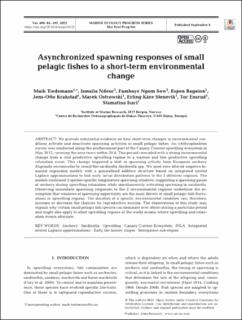| dc.contributor.author | Tiedemann, Maik | |
| dc.contributor.author | Ndour, Ismaïla | |
| dc.contributor.author | Sow, Fambaye Ngom | |
| dc.contributor.author | Bagøien, Espen | |
| dc.contributor.author | Krakstad, Jens-Otto | |
| dc.contributor.author | Ostrowski, Marek | |
| dc.contributor.author | Stenevik, Erling Kåre | |
| dc.contributor.author | Ensrud, Tor Magne | |
| dc.contributor.author | Isari, Stamatina | |
| dc.date.accessioned | 2022-09-21T12:09:34Z | |
| dc.date.available | 2022-09-21T12:09:34Z | |
| dc.date.created | 2022-09-13T09:10:13Z | |
| dc.date.issued | 2022 | |
| dc.identifier.citation | Marine Ecology Progress Series. 2022, 696 85-102. | en_US |
| dc.identifier.issn | 0171-8630 | |
| dc.identifier.uri | https://hdl.handle.net/11250/3020218 | |
| dc.description.abstract | We provide substantial evidence on how short-term changes in environmental conditions activate and deactivate spawning activities in small pelagic fishes. An ichthyoplankton survey was conducted along the southernmost part of the Canary Current upwelling ecosystem in May 2013, covering the area twice within 20 d. This period coincided with a strong environmental change from a cold productive upwelling regime to a warmer and less productive upwelling relaxation event. This change triggered a shift in spawning activity from European anchovy Engraulis encrasicolus to round/flat sardinella Sardinella spp. We used zero-altered negative binomial regression models with a generalized additive structure based on integrated nested Laplace approximations to link early larval distribution patterns to the 2 different regimes. The models confirmed 2 species-specific temperature spawning windows, suggesting a spawning pause of anchovy during upwelling relaxation while simultaneously activating spawning in sardinella. Observing immediate spawning responses to the 2 environmental regimes underlines the assumption that windows of spawning opportunity are the main drivers of small pelagic fish fluctuations in upwelling regions. The duration of a specific environmental condition can, therefore, increase or decrease the chances for reproductive success. The observations of this study may explain why certain small pelagic fish species can dominate over others during a particular period and might also apply to other upwelling regions of the world oceans where upwelling and relaxation events alternate. | en_US |
| dc.language.iso | eng | en_US |
| dc.title | Asynchronized spawning responses of small pelaigic fish to a short-term enviromental change | en_US |
| dc.title.alternative | Asynchronized spawning responses of small pelaigic fish to a short-term enviromental change | en_US |
| dc.type | Peer reviewed | en_US |
| dc.type | Journal article | en_US |
| dc.description.version | publishedVersion | en_US |
| dc.source.pagenumber | 85-102 | en_US |
| dc.source.volume | 696 | en_US |
| dc.source.journal | Marine Ecology Progress Series | en_US |
| dc.identifier.doi | 10.3354/meps14122 | |
| dc.identifier.cristin | 2051045 | |
| cristin.ispublished | true | |
| cristin.fulltext | original | |
| cristin.qualitycode | 2 | |
